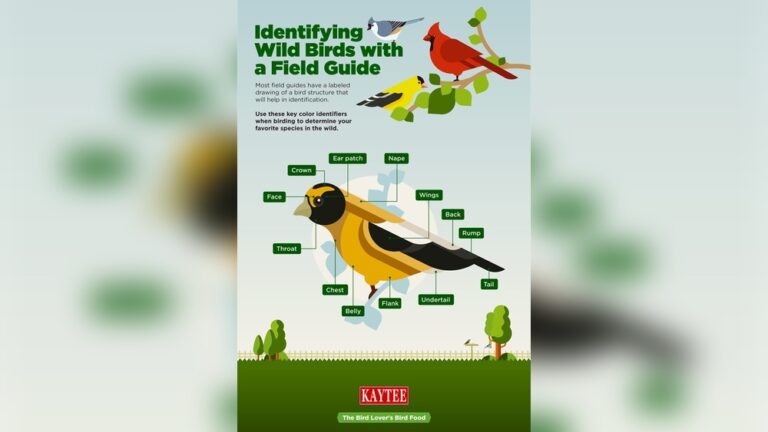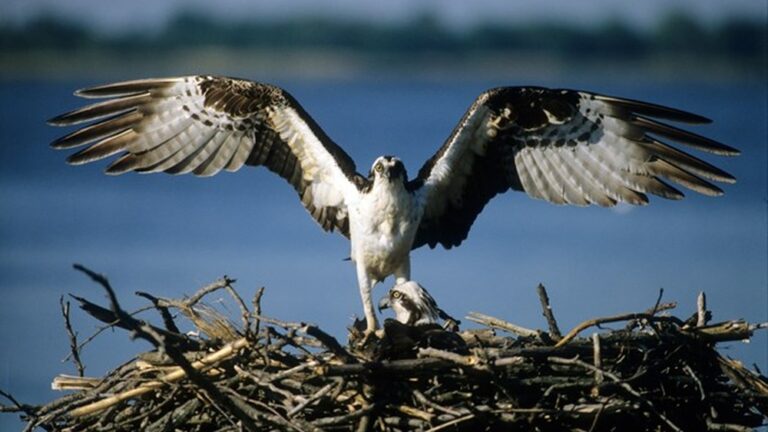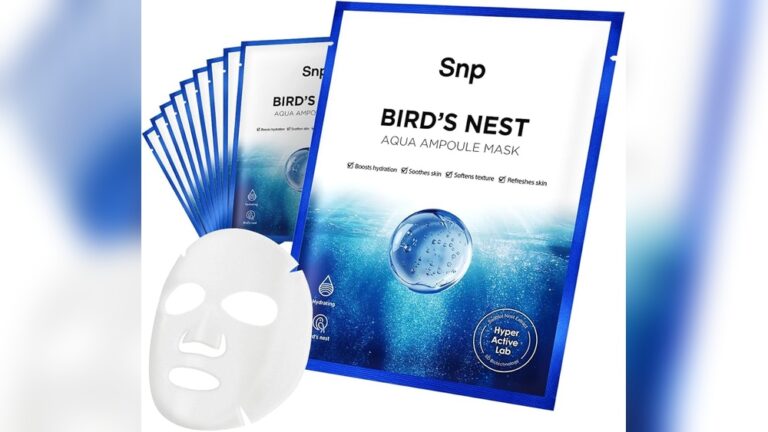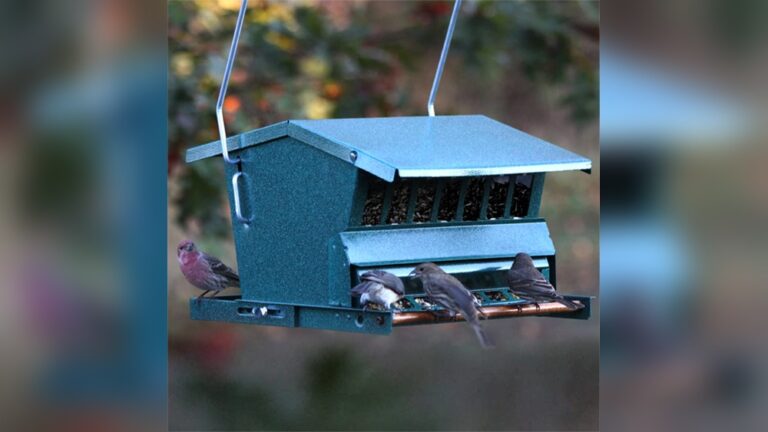Backyard Bird Feeder Setups
Imagine turning your backyard into a lively sanctuary filled with colorful birds and soothing sounds. With the right backyard bird feeder setups, you can invite nature’s most charming visitors right to your window.
Whether you’re a beginner or looking to upgrade your current feeders, this guide will help you create the perfect space that attracts a variety of birds. Ready to discover how simple changes can bring more life and joy to your outdoor space?
Keep reading, and your backyard will never be the same.

Credit: www.natureswaybirds.com
Choosing The Right Feeder
Choosing the right bird feeder makes a big difference in attracting birds to your backyard. The feeder you select affects which birds visit and how often they come. Consider the types of birds you want to attract and where you want to place the feeder. Selecting the right feeder keeps birds safe and makes feeding easy for them. This section explains important points to help you pick the best feeder for your yard.
Types Of Bird Feeders
Tube feeders are popular and hold seeds well. They attract small birds like finches and chickadees. Platform feeders are flat and open. They work for many bird types but may attract squirrels. Hopper feeders store seeds in a container and release them slowly. They suit medium to large birds. Suet feeders hold fat cakes and attract woodpeckers and nuthatches. Choose a feeder type based on the birds you want to see.
Materials And Durability
Plastic feeders are lightweight and affordable. They may crack in cold weather or fade in sun. Metal feeders last longer and resist damage. Look for rust-resistant metal types. Wood feeders look natural and blend well with gardens. They need regular cleaning and protection from moisture. Glass feeders are beautiful but fragile. Pick a feeder material that fits your climate and budget.
Placement Tips
Place feeders where birds feel safe from predators. Near trees or bushes is ideal for cover. Avoid placing feeders too close to windows to prevent collisions. Keep feeders away from busy walkways and pets. Mount feeders at least five feet above the ground. This height helps protect birds from cats. Rotate feeder spots occasionally to avoid disease buildup. Good placement encourages more birds to visit your feeder.
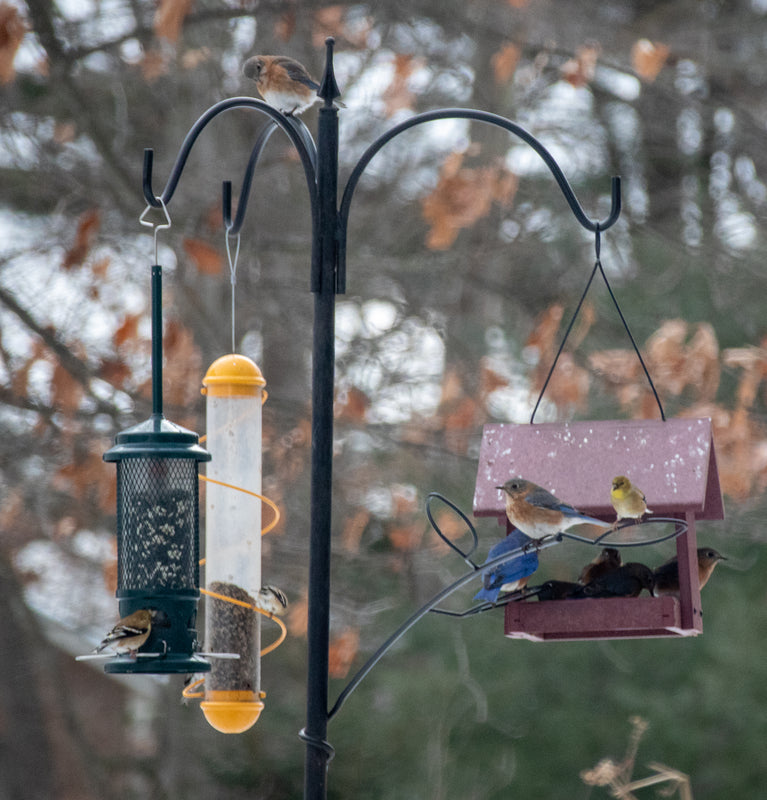
Credit: nature-niche.com
Selecting Bird Food
Selecting the right food is key for a successful backyard bird feeder setup. Birds need different types of food. Choosing the right seeds and mixes attracts more birds. It also helps keep them healthy and happy.
Popular Seeds And Mixes
Sunflower seeds are a favorite for many birds. Black oil sunflower seeds attract finches, chickadees, and cardinals. Millet is good for sparrows and doves. Mixed seed blends combine various seeds to attract many bird types. Avoid cheap mixes with fillers like red millet or wheat.
Food For Specific Birds
Different birds prefer different foods. Nyjer seeds are loved by finches. Peanuts attract woodpeckers and jays. Suet cakes feed insect-eaters in cold months. Mealworms provide protein for bluebirds and robins. Offer fruit for orioles and waxwings. Tailor food choices to the birds in your area.
Seasonal Feeding Options
Food needs change with the seasons. In winter, high-fat foods like suet and peanuts help birds stay warm. Spring and summer call for fresh fruits and mealworms for nesting birds. In fall, offer seeds and berries to prepare birds for migration. Change food to match seasonal bird habits and needs.
Creating A Bird-friendly Habitat
Creating a bird-friendly habitat in your backyard invites more birds to visit and stay. It supports their needs for food, shelter, and water. Birds feel safe and comfortable in natural settings. This encourages them to build nests and raise their young. You can enjoy watching many types of birds every day.
Native Plants And Shelter
Use native plants to attract local birds. These plants provide natural food like seeds and berries. They also offer shelter from wind and predators. Shrubs and trees create good hiding spots. Plants with dense leaves protect nests and young birds. Choose a variety of plants for different birds. This helps maintain a balanced environment.
Water Sources
Birds need fresh water for drinking and bathing. A shallow birdbath is perfect for this. Keep the water clean and change it often. Small ponds or fountains also work well. Moving water attracts more birds and keeps mosquitoes away. Place water sources near shelter for safety. This makes birds feel secure while drinking.
Safe Environment Practices
Keep your backyard safe by avoiding pesticides and chemicals. These can harm birds and their food sources. Place feeders and baths away from windows. This prevents birds from hitting glass. Keep pets, especially cats, away from feeding areas. Protect nests by limiting human disturbance. A safe space helps birds thrive and return often.

Credit: www.reddit.com
Maintaining Your Feeder Setup
Maintaining your backyard bird feeder setup keeps birds healthy and happy. Clean and well-stocked feeders attract more birds. Regular care prevents disease and pest problems. A few simple steps make your feeder safe and inviting all year.
Cleaning And Hygiene
Clean feeders every two weeks with warm water and mild soap. Rinse well to remove all soap residue. Avoid harsh chemicals that can harm birds. Dry feeders completely before refilling. Remove old seeds and debris daily. Clean seed trays and perches to stop mold growth.
Refilling Strategies
Refill feeders regularly to keep seeds fresh. Avoid overfilling to prevent seed waste and spoilage. Store seeds in a cool, dry place. Use fresh seeds to attract a variety of birds. Check feeders often during busy feeding times. Rotate different seed types to invite more bird species.
Pest Control
Use squirrel baffles to keep pests away. Place feeders away from walls to reduce rodent access. Clean spilled seeds from the ground to avoid attracting unwanted animals. Use bird-friendly feeders that limit pest entry. Keep the area around feeders tidy and free of debris. Regular maintenance reduces pest problems effectively.
Attracting Different Bird Species
Creating a backyard bird feeder setup that attracts many bird species brings nature closer. Different birds prefer different foods and feeder types. Understanding these preferences helps attract a variety of birds. This section explains how to appeal to many species in your backyard.
Bird Behavior Insights
Birds have unique habits and food tastes. Some like seeds, while others prefer nectar or insects. Birds also differ in how they feed. Some eat on the ground, others prefer hanging feeders. Knowing these habits guides the choice of feeder and food. Quiet, safe spots near trees or shrubs attract shy birds.
Using Feeders To Encourage Diversity
Offer various feeders to invite many birds. Tube feeders suit small songbirds. Platform feeders attract larger birds. Suet feeders bring woodpeckers and nuthatches. Use mixed seeds, sunflower seeds, or peanuts to please different tastes. Water sources like birdbaths also invite more species. Changing feeder spots can attract new visitors.
Seasonal Bird Watching
Bird species change with the seasons. In spring, expect bright warblers and robins. Summer brings hummingbirds and finches. Fall attracts sparrows and juncos. Winter feeders often see chickadees and cardinals. Adjust food types and feeder styles through the year. Seasonal care keeps birds returning regularly.
How Smart Pets Lover Can Help You with Backyard Bird Feeder Setups
Learning Through Your Backyard Bird Feeder Setup
Setting up a backyard bird feeder isn’t just about attracting feathered friends—it’s a wonderful chance to learn and connect with nature right outside your window. By choosing the right feeder and selecting bird food thoughtfully, you create a dynamic outdoor classroom where you can observe different species and their behaviors. This hands-on experience deepens your understanding of how to maintain a bird-friendly habitat, reinforcing the importance of responsible pet ownership and environmental care.
As you watch various birds visit, take notes on their feeding preferences and habits, which can inform future tweaks to your setup. This practical learning aligns with Smart Pets Lover’s mission to help pet parents feel confident and connected—not only with their pets but with all creatures they cherish. For any questions or expert advice on bird care, reaching out to local wildlife organizations or resources like Smart Pets Lover can offer valuable insights, making your backyard a vibrant, educational space where every chirp truly tells a story.
Frequently Asked Questions
What Are The Best Bird Feeder Types For Backyards?
Tube feeders, platform feeders, and suet feeders attract various birds. Choose based on bird species and seed type for best results.
How Can I Keep Squirrels Away From Bird Feeders?
Use squirrel baffles, weight-sensitive feeders, or place feeders away from trees. These methods effectively deter squirrels without harming birds.
What Seeds Attract The Most Backyard Birds?
Black oil sunflower seeds, nyjer, and millet attract many bird species. Offering a mix ensures a diverse bird population visits your feeder.
How Often Should I Clean My Bird Feeders?
Clean feeders every two weeks to prevent disease. Use a mild bleach solution, rinse well, and dry before refilling.
Conclusion
Creating a backyard bird feeder setup brings nature closer to home. Birds visit more often when feeders are clean and filled with fresh seeds. Different feeders attract different types of birds. Place feeders where you can watch easily. Remember to keep feeders safe from predators.
Feeding birds supports local wildlife and adds beauty to your yard. Small efforts make a big difference for bird lovers. Enjoy the sights and sounds of your feathered friends every day.

